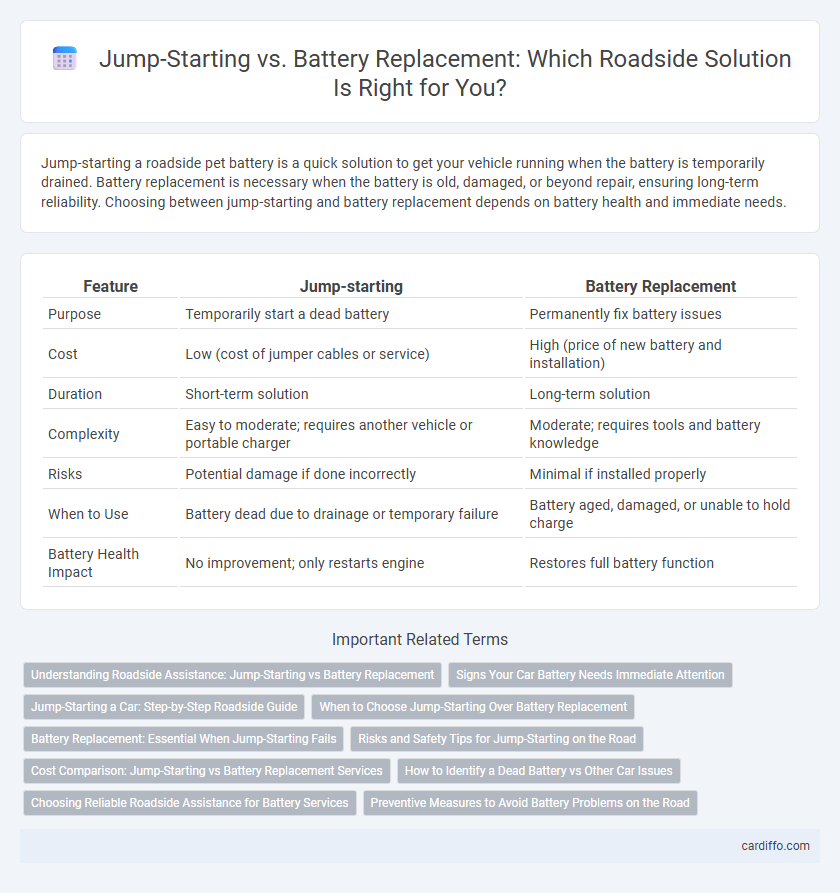Jump-starting a roadside pet battery is a quick solution to get your vehicle running when the battery is temporarily drained. Battery replacement is necessary when the battery is old, damaged, or beyond repair, ensuring long-term reliability. Choosing between jump-starting and battery replacement depends on battery health and immediate needs.
Table of Comparison
| Feature | Jump-starting | Battery Replacement |
|---|---|---|
| Purpose | Temporarily start a dead battery | Permanently fix battery issues |
| Cost | Low (cost of jumper cables or service) | High (price of new battery and installation) |
| Duration | Short-term solution | Long-term solution |
| Complexity | Easy to moderate; requires another vehicle or portable charger | Moderate; requires tools and battery knowledge |
| Risks | Potential damage if done incorrectly | Minimal if installed properly |
| When to Use | Battery dead due to drainage or temporary failure | Battery aged, damaged, or unable to hold charge |
| Battery Health Impact | No improvement; only restarts engine | Restores full battery function |
Understanding Roadside Assistance: Jump-Starting vs Battery Replacement
Roadside assistance often covers both jump-starting and battery replacement, crucial services when a vehicle won't start due to electrical issues. Jump-starting provides a temporary boost to restart a dead battery, while battery replacement resolves long-term power problems by installing a new battery. Understanding the difference helps drivers choose the appropriate service, reducing downtime and ensuring vehicle reliability.
Signs Your Car Battery Needs Immediate Attention
Dimming headlights, slow engine crank, and frequent jump-starts are clear signs your car battery requires immediate attention. Corroded battery terminals and a swollen battery case indicate deterioration that could lead to sudden failure. Opting for a jump-start is a temporary fix, while a battery replacement ensures reliable roadside performance and prevents unexpected breakdowns.
Jump-Starting a Car: Step-by-Step Roadside Guide
Jump-starting a car involves connecting jumper cables from a working vehicle's battery to the dead battery, ensuring proper connection order: positive to positive, negative to a grounding point on the dead car. This process temporarily provides the necessary power to start the engine without immediate battery replacement. Following safety measures and correct cable attachment helps avoid electrical damage and ensures a successful roadside jump-start.
When to Choose Jump-Starting Over Battery Replacement
Jump-starting is ideal when the vehicle's battery is temporarily drained due to headlights left on or extreme cold but still holds a charge, allowing a quick restart without immediate replacement. Battery replacement becomes necessary when the battery is old, shows signs of corrosion, or fails to retain charge despite jump-start attempts. Choosing jump-starting over replacement saves time and cost in emergencies where the battery condition remains fundamentally sound.
Battery Replacement: Essential When Jump-Starting Fails
Battery replacement becomes essential when jump-starting fails to revive a dead car battery, indicating the battery has reached the end of its life cycle or suffers from internal damage. Modern vehicle batteries typically last three to five years, but extreme temperatures and frequent short trips accelerate deterioration, necessitating timely replacement. Professional roadside services use diagnostic tools to assess battery health and ensure the correct replacement battery type and capacity for optimal vehicle performance.
Risks and Safety Tips for Jump-Starting on the Road
Jump-starting a vehicle on the road carries risks such as electrical damage, personal injury, and potential battery explosion if not done correctly. It is crucial to wear protective gloves and goggles, ensure both vehicles have compatible batteries, and keep metal objects away from the battery terminals to prevent sparks. Always follow proper jump-starting procedures and consider professional battery replacement if the battery is severely damaged or old to avoid roadside hazards.
Cost Comparison: Jump-Starting vs Battery Replacement Services
Jump-starting a vehicle typically costs between $50 and $100, offering a quick and affordable solution to a dead battery. Battery replacement services, however, can range from $120 to $300 or more depending on battery type, vehicle model, and labor charges. Choosing jump-starting saves money in the short term, but replacement is a necessary long-term investment for reliable vehicle performance.
How to Identify a Dead Battery vs Other Car Issues
A dead battery is identifiable by dim headlights, slow engine crank, and lack of electrical power despite turning the key. In contrast, starter motor problems often produce a clicking sound, while alternator failure may cause flickering lights or electrical system malfunctions. Checking battery voltage with a multimeter and inspecting terminals for corrosion helps distinguish battery issues from other mechanical faults.
Choosing Reliable Roadside Assistance for Battery Services
Choosing reliable roadside assistance for battery services ensures expert jump-starting and accurate battery replacement, preventing recurring issues and vehicle downtime. Trusted providers use advanced diagnostics to identify battery health and deliver efficient, safe solutions tailored to specific vehicle models. Prioritizing certified technicians and timely response enhances roadside battery support, boosting vehicle reliability and driver confidence.
Preventive Measures to Avoid Battery Problems on the Road
Regular battery maintenance, such as checking terminal cleanliness and ensuring secure connections, significantly reduces the risk of roadside battery failure. Using a multimeter to monitor voltage levels helps detect weak batteries before they cause trouble. Keeping jumper cables or a portable jump starter in the vehicle provides a reliable backup, but proactive battery replacement based on age and performance metrics prevents unexpected breakdowns.
Jump-starting vs Battery Replacement Infographic

 cardiffo.com
cardiffo.com